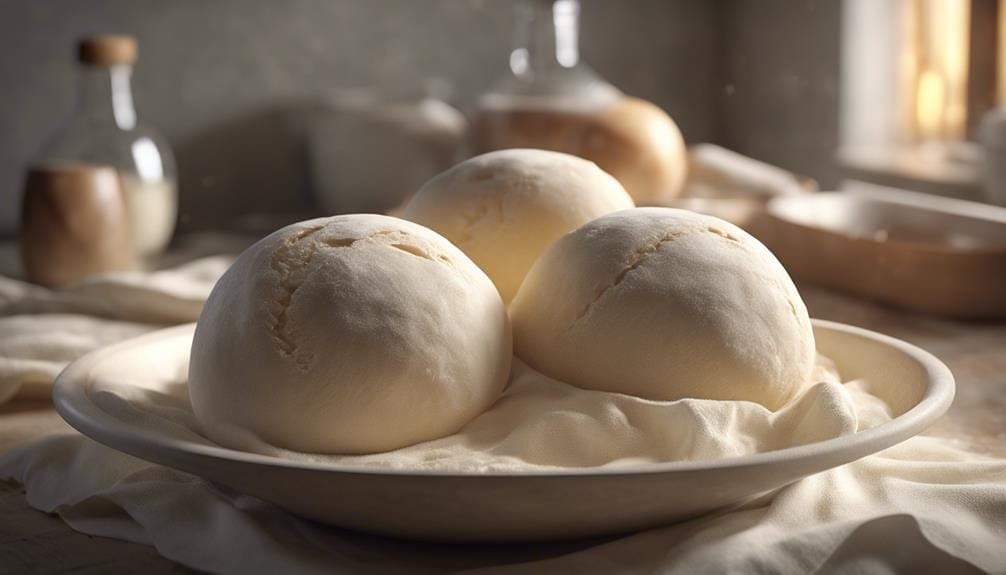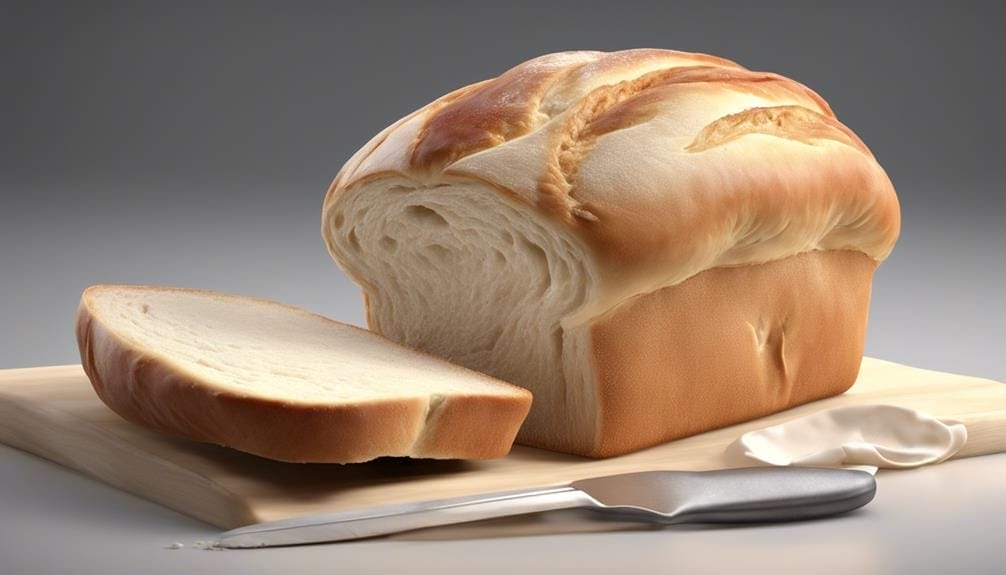To price your homemade white bread effectively, consider the cost of your ingredients like flour, yeast, water, sugar, and salt. Estimate the total amount needed per loaf and calculate the price per ingredient. Factor in additional costs such as electricity for baking, packaging, and any special equipment used. Determine your desired profit margin, labor included. Calculate the total cost to make the bread and divide by the number of loaves produced to set a fair price. Remember, quality ingredients and your time and effort deserve fair compensation. For further insights on pricing homemade goods, investigate key factors to guarantee success.
Essential Ingredients
For making delicious white bread, you must gather the key ingredients like flour, yeast, water, sugar, salt, and oil. In the bread-making process, these components play essential roles.
Flour provides the structure and foundation of the bread, while yeast is responsible for the critical rising action. Active dry yeast is a common choice to achieve that fluffy texture.
Water acts as the hydrating agent, activating the yeast and ensuring proper dough development. Sugar not only adds a touch of sweetness but also aids in fermentation.
Salt enhances the flavor profile of the bread and helps regulate the fermentation process for the best rise and structure. Furthermore, oil, whether vegetable or olive oil, enriches the dough and contributes to a softer final texture.
Understanding the importance of each ingredient and their specific functions is key to mastering the art of baking delicious white bread at home.
Mixing and Kneading Process
To ensure your white bread turns out soft and fluffy, it's essential to understand the mixing and kneading process thoroughly. The mixing process involves gradually combining dry and wet ingredients in a mixer bowl, ensuring an even distribution for a well-blended dough.
Kneading is where the magic happens – it develops gluten, giving the bread structure and creating an elastic dough. Proper kneading technique is important to achieving a smooth and consistent texture in your bread.
Follow specific mixing instructions, gradually adding ingredients to achieve the perfect dough consistency. When kneading, aim for a smooth and elastic dough. Over-kneading can lead to a tough loaf, while under-kneading may result in a dense texture.
Consistent kneading throughout is key for a successful white bread outcome. By understanding and mastering the mixing and kneading process, you'll be on your way to baking delicious homemade white bread every time.
Proofing and Rising Time

Make sure your white bread dough undergoes proper proofing and rising to achieve the desired texture and flavor. The proofing time in a white bread recipe usually lasts between 1 to 2 hours, allowing the yeast to ferment and produce carbon dioxide for the dough to rise.
During the rising process, the dough should double in size, indicating that fermentation and gluten development are happening correctly. Factors such as ambient temperature, yeast activity, and dough consistency play important roles in determining the required proofing time.
Over-proofing can lead to a collapsed loaf with a dense texture, while under-proofing may result in a smaller, less airy bread. Ensuring the dough is proofed just right is essential for achieving a light, fluffy texture and ideal flavor in your homemade white bread.
Keep an eye on the proofing process to avoid over-proofing or under-proofing, as it can greatly impact the final outcome of your delicious loaf.
Shaping the Loaf
Shape the loaf by dividing the dough, rolling it into a rectangle, and tightly rolling it up to achieve the classic loaf shape. Proper shaping is essential to guarantee an even distribution of air bubbles and a uniform texture in your finished bread.
When tucking the ends of the rolled dough underneath, you not only create a smooth surface but also prevent the loaf from unraveling during baking. Remember to place the shaped dough seam-side down in the loaf pan for an even rise and a well-formed loaf.
A well-shaped loaf isn't only visually appealing but also results in a consistent crumb structure and a nice crust. By following these simple steps for shaping the loaf, you can ensure a beautifully baked bread that will be as delightful to look at as it's to eat.
Baking and Enjoying

When your white bread has baked to a golden brown hue, it's time to savor the comforting warmth and delicious aroma it brings to your kitchen. Homemade white bread, fresh out of the oven, is a treat like no other. The anticipation builds as the loaf rises and the dough transforms into a golden-brown masterpiece.
Once baked, the warm bread is ready to be enjoyed in different ways. Spread some butter or jam on a slice, or make a hearty sandwich for a fulfilling meal.
The process of baking homemade white bread isn't just about creating a loaf; it's about indulging in the experience of making something from scratch. The smell that fills your home as it bakes is unmatched. Plus, the soft, fluffy texture of homemade white bread is perfect for any occasion.
Whether you slice it thin or thick, the satisfaction of enjoying a slice of warm, golden-brown bread is simply delightful. So, go ahead, take a bite, and relish in the simple pleasure of homemade bread.
Frequently Asked Questions
What Are the Ingredients for White Bread?
For white bread, you'll need all-purpose flour, yeast for rising, sugar to feed the yeast, salt for flavor, and fat like oil or butter for richness. These ingredients come together to create a classic loaf.
What Are the 7 Main Ingredients in Bread?
To make bread, you need flour, yeast, water, salt, sugar, milk, and fat like butter or oil. These ingredients work together to create a tasty loaf. Don't forget about the yeast for that perfect rise!
What Are the Original Ingredients in Bread?
To make bread, start with basic ingredients like flour, water, yeast, sugar, salt, and sometimes oil. These work together for a simple, delicious result. Adjusting proportions and trying different flour types can yield unique flavors and textures.
How to Make White Bread More Flavorful?
To make white bread more flavorful, try adding savory spreads or sweet toppings. Experiment with seasoning options like garlic powder or rosemary. Elevate the taste with creative pairings of herbs and spices for tasty twists.
Conclusion
Now that you've mastered the art of baking delicious white bread with just 5 simple ingredients, you can enjoy the satisfaction of homemade bread whenever you like.
Experiment with different shapes, sizes, and flavors to make this recipe your own.
Remember, practice makes perfect, so keep refining your skills and enjoying the process of creating fresh bread from scratch.
Happy baking!